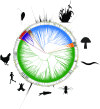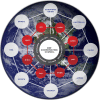Earth BioGenome Project: Sequencing life for the future of life
- PMID: 29686065
- PMCID: PMC5924910
- DOI: 10.1073/pnas.1720115115
Earth BioGenome Project: Sequencing life for the future of life
Abstract
Increasing our understanding of Earth's biodiversity and responsibly stewarding its resources are among the most crucial scientific and social challenges of the new millennium. These challenges require fundamental new knowledge of the organization, evolution, functions, and interactions among millions of the planet's organisms. Herein, we present a perspective on the Earth BioGenome Project (EBP), a moonshot for biology that aims to sequence, catalog, and characterize the genomes of all of Earth's eukaryotic biodiversity over a period of 10 years. The outcomes of the EBP will inform a broad range of major issues facing humanity, such as the impact of climate change on biodiversity, the conservation of endangered species and ecosystems, and the preservation and enhancement of ecosystem services. We describe hurdles that the project faces, including data-sharing policies that ensure a permanent, freely available resource for future scientific discovery while respecting access and benefit sharing guidelines of the Nagoya Protocol. We also describe scientific and organizational challenges in executing such an ambitious project, and the structure proposed to achieve the project's goals. The far-reaching potential benefits of creating an open digital repository of genomic information for life on Earth can be realized only by a coordinated international effort.
Keywords: access and benefit sharing; biodiversity; data science; genome sequencing; genomics.
Conflict of interest statement
The authors declare no conflict of interest.
Figures



References
-
- Wilson EO. The Diversity of Life. Norton; New York: 1999.
-
- World Wildlife Fund 2016. Living Planet Report 2016: Risk and resilience in a new era (World Wildlife Fund, Gland, Switzerland)
-
- International Union for Conservation of Nature 2017. IUCN 2016: International Union for Conservation of Nature annual report 2016 (International Union for Conservation of Nature, Gland, Switzerland)
Publication types
MeSH terms
Grants and funding
LinkOut - more resources
Full Text Sources
Other Literature Sources

